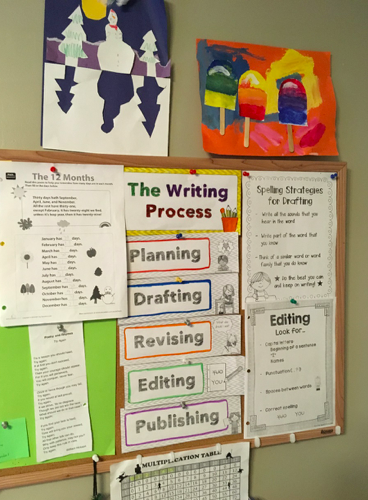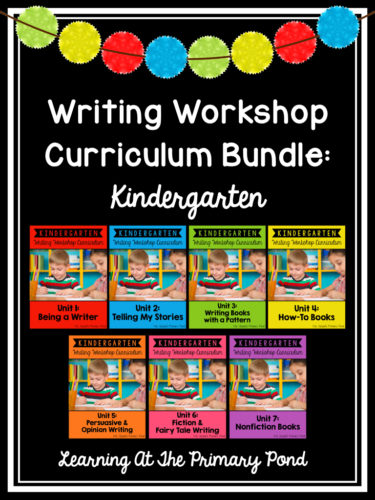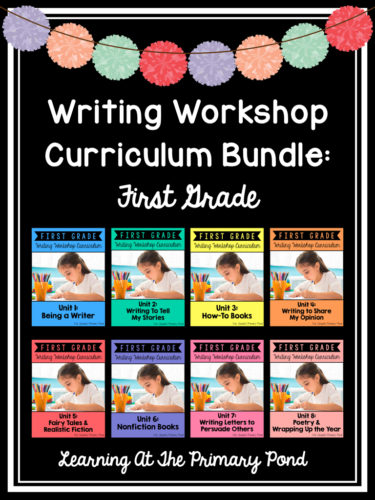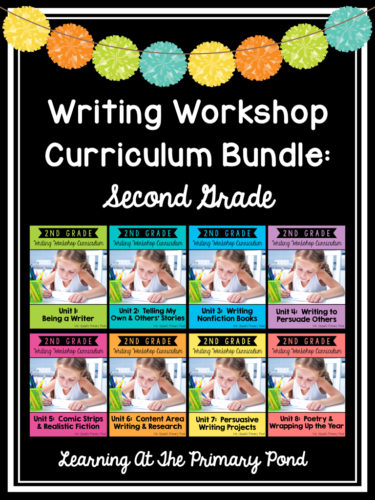As a literacy specialist and classroom teacher with experience in Kindergarten, 1st, and 2nd grade, I didn’t have the resources that I needed to teach writing. So I created my own!
I researched best practices and took note of what worked with my students. My goal was always to create developmentally appropriate lessons that would challenge my students and get them EXCITED about writing!
Today, thousands of teachers use these writing resources in their own classrooms. But I sometimes get asked – are these materials appropriate for homeschooling families?
A number of homeschooling families have used my writing bundles. But if you’re a homeschooling parent considering using these resources, you might be wondering, “Are these materials right for me?” And since I’ve never homeschooled before, I think the best two steps for you to take are:
- To download the free preview file for the bundle you’re considering (Kindergarten, first, or second grade)
- Read homeschooling mama Lindsey Hilty’s review.
Lindsey was kind enough to review my writing bundles and share her honest opinion (as well as tips for adapting the materials for a homeschool setting)! She did receive the 1st grade and 2nd grade materials for free from me, but below I’ve included her review, unedited by me.
After you have a read and download the preview to the bundle you’re considering, please do feel free to email me at Alison@learningattheprimarypond.com. I’m happy to answer any questions you might have – either before purchasing or while you are using the materials!
Lindsey’s Review:
I’m a journalist who loves to write, so I thought teaching my child to write would be easy. I was a wrong. A subject dear to my heart was a subject my son dreaded. For our first homeschool year of first-grade, I used fun writing prompts to develop his skills. The problem was that writing prompts did not give him step-by-step writing instruction on how to write, or how to improve his work. I loved the idea of writing workshop in the public school, and he had very much enjoyed the writing workshop process in kindergarten.
That’s when I discovered Learning at the Primary Pond. It’s a curriculum for educators in a classroom, but I decided it would be perfect for a homeschool environment. Alison gave us a chance to test it out as a homeschool family, and I highly recommend it to other homeschool families.

(Alison provides some great printables, and I printed several to decorate my son’s school desk area.)
The Curriculum Hunt
Homeschool parents seem to spend a lot of time and energy searching for the ideal curriculum. There are countless wonderful resources, so narrowing the choices is difficult. On my hunt, many programs I researched had limitations.
- I needed something that taught writing step-by-step in a creative way.
- I needed something that I could adapt to my son, who has had an uphill battle to master fine motor skills and handwriting tasks.
- I needed something that would ensure he was staying on grade level with his peers, and continued to meet standards. (Many homeschool curriculums/ philosophies delay writing until children have a better handle on spelling and grammar, but I wanted him to at least understand the writing process, even if his work wasn’t perfect.)
- I needed something engaging and easy to use without a lot of lesson planning.
What I like about Learning at the Primary Pond
- The lesson plans are all inclusive. Each unit comes with step-by-step instructions, mentor texts, online resource hints, and even a teacher script I could read and adapt to one child.
- Each unit comes with grammar exercises to practice in context.
- Each unit is adaptable to individual writing levels and builds upon/reinforces skills learned in past units. This makes the second-grade curriculum adaptable for multiple ages of children, because they all can learn the techniques and develop their skills accordingly.
- Each unit comes with rubrics for my child and me to look at together to make sure each final draft includes all the necessary elements.
- Mentor texts give great examples of writing, and how we can continue to improve our drafts as we go. Also helpful was if I forgot to order a mentor text from the library, I was almost always able to find a YouTube video online of someone else reading the book.
- All graphic organizers, lined paper options and even writing examples by Allison were provided to make the curriculum all inclusive.
- I could choose the order of the units, so we didn’t get too bogged down in an area that was not as interesting to my son. We could jump around, but we always had the consistency of Alison’s teaching process helping us through each draft step by step.
What I had to do to adapt the curriculum
- My biggest frustration was printing. There are a lot of pages to print, and I didn’t need everything offered in the package. I spent quite a bit of time hunting through and attempting to save ink. Once I printed a unit, I stored it in a giant binder. (Alison’s note: I think Lindsey had an older version of the materials – I have since made the bundles easier to print. I am also happy to provide you with an image-free copy of the lesson plans in case you want to edit or print just those materials all at once!)
- Many of the activities are obviously geared to a large class, including group and partner work. I had to get a little creative to adapt to our one-on-one environment, but I felt like we were successful with our minor adaptations.
- I tied in some of the assignments to what we were learning at the time. So, our research report was not on animals, but rather on Roman Aqueducts. I loved the flexibility.
- I wanted the lessons to correlate to daily writing assignments, but there was no way my son was going to write for the length of time kids are writing in a classroom. At first, I struggled to adjust to this idea, since the lessons are meant to inspire the children as they work on several writing assignments for the unit. I adapted by using each lesson to teach a concept, but sometimes we only wrote small chunks of our assignment. That meant we worked together to fill out a planning sheet one day. The next day we would work on the opening. Then, we would work on the middle. Finally, we would work on our ending. We took our time working on editing. This allowed us to write only one or two pieces per section Rewriting was painful, but we made it through by doing one page at a time. Often, I would allow my son to dictate to me, and I would do the act of writing in order to get his ideas on paper more easily.
Moving Forward
As I became more familiar with the curriculum, and adapted it to my son’s learning style, he actually found his groove with writing. He was seriously inspired by the comic and graphic novel unit, as well as the poetry unit. Because we battled over the handwriting piece, we figured out during the realistic fiction unit how to work through dictation. We spent a week going through the draft and adding to that story to make it even better. We were both so happy with the results as we checked off each part of the writing rubric. Granted, he didn’t have to worry about the grammar and spelling, but he has grammar and spelling lessons for that. My goal was to get him to enjoy creating with words, and I finally feel like we have made it to that point. If I can’t find a good third-grade program, we may adapt this same curriculum and do it again next year with some added grammar lessons. I really am excited to see his love for writing grow. Who knows – the kid who would kick and scream at the mere sound of “writing workshop time” at the beginning of this school year, may grow up to be a famous author. I can’t wait to find out.





